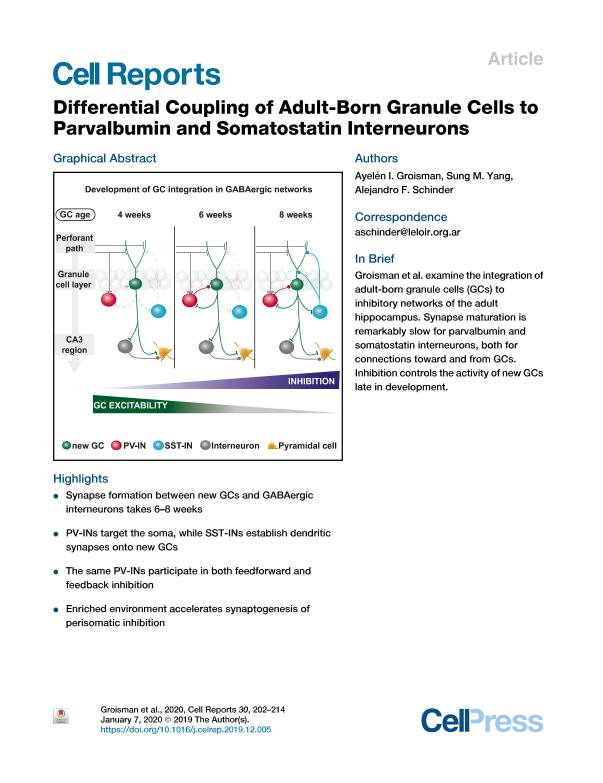Mostrar el registro sencillo del ítem
dc.contributor.author
Groisman, Ayelén Ivana

dc.contributor.author
Yang, Sung Min

dc.contributor.author
Schinder, Alejandro Fabián

dc.date.available
2021-06-07T11:01:44Z
dc.date.issued
2020-01
dc.identifier.citation
Groisman, Ayelén Ivana; Yang, Sung Min; Schinder, Alejandro Fabián; Differential Coupling of Adult-Born Granule Cells to Parvalbumin and Somatostatin Interneurons; Elsevier Inc; Cell Reports; 30; 1; 1-2020; 202-214
dc.identifier.issn
2211-1247
dc.identifier.uri
http://hdl.handle.net/11336/133307
dc.description.abstract
A strong GABAergic tone imposes sparse levels of activity in the dentate gyrus of the hippocampus. This balance is challenged by the addition of new granule cells (GCs) with high excitability. How developing GCs integrate within local inhibitory networks remains unknown. We used optogenetics to study synaptogenesis between new GCs and GABAergic interneurons expressing parvalbumin (PV-INs) and somatostatin (SST-INs). PV-INs target the soma, and synapses become mature after 6 weeks. This transition is accelerated by exposure to an enriched environment. PV-INs exert efficient control of GC spiking and participate in both feedforward and feedback loops, a mechanism that would favor lateral inhibition and sparse coding. SST-INs target the dendrites, and synapses mature after 8 weeks. Outputs from GCs onto PV-INs develop faster than those onto SST-INs. Our results reveal a long-lasting transition wherein adult-born neurons remain poorly coupled to inhibition, which might enhance activity-dependent plasticity of input and output synapses. Groisman et al. examine the integration of adult-born granule cells (GCs) to inhibitory networks of the adult hippocampus. Synapse maturation is remarkably slow for parvalbumin and somatostatin interneurons, both for connections toward and from GCs. Inhibition controls the activity of new GCs late in development.
dc.format
application/pdf
dc.language.iso
eng
dc.publisher
Elsevier Inc

dc.rights
info:eu-repo/semantics/openAccess
dc.rights.uri
https://creativecommons.org/licenses/by-nc-sa/2.5/ar/
dc.subject
EXCITATION
dc.subject
INHIBITION
dc.subject.classification
Otras Ciencias Médicas

dc.subject.classification
Otras Ciencias Médicas

dc.subject.classification
CIENCIAS MÉDICAS Y DE LA SALUD

dc.title
Differential Coupling of Adult-Born Granule Cells to Parvalbumin and Somatostatin Interneurons
dc.type
info:eu-repo/semantics/article
dc.type
info:ar-repo/semantics/artículo
dc.type
info:eu-repo/semantics/publishedVersion
dc.date.updated
2020-06-23T15:10:47Z
dc.identifier.eissn
2211-1247
dc.journal.volume
30
dc.journal.number
1
dc.journal.pagination
202-214
dc.journal.pais
Estados Unidos

dc.journal.ciudad
Cambridge
dc.description.fil
Fil: Groisman, Ayelén Ivana. Consejo Nacional de Investigaciones Científicas y Técnicas. Oficina de Coordinación Administrativa Parque Centenario. Instituto de Investigaciones Bioquímicas de Buenos Aires. Fundación Instituto Leloir. Instituto de Investigaciones Bioquímicas de Buenos Aires; Argentina
dc.description.fil
Fil: Yang, Sung Min. Consejo Nacional de Investigaciones Científicas y Técnicas. Oficina de Coordinación Administrativa Parque Centenario. Instituto de Investigaciones Bioquímicas de Buenos Aires. Fundación Instituto Leloir. Instituto de Investigaciones Bioquímicas de Buenos Aires; Argentina
dc.description.fil
Fil: Schinder, Alejandro Fabián. Consejo Nacional de Investigaciones Científicas y Técnicas. Oficina de Coordinación Administrativa Parque Centenario. Instituto de Investigaciones Bioquímicas de Buenos Aires. Fundación Instituto Leloir. Instituto de Investigaciones Bioquímicas de Buenos Aires; Argentina
dc.journal.title
Cell Reports
dc.relation.alternativeid
info:eu-repo/semantics/altIdentifier/doi/http://dx.doi.org/10.1016/j.celrep.2019.12.005
dc.relation.alternativeid
info:eu-repo/semantics/altIdentifier/url/https://www.cell.com/cell-reports/fulltext/S2211-1247(19)31644-4
dc.relation.alternativeid
info:eu-repo/semantics/altIdentifier/url/https://www.sciencedirect.com/science/article/pii/S2211124719316444
Archivos asociados
